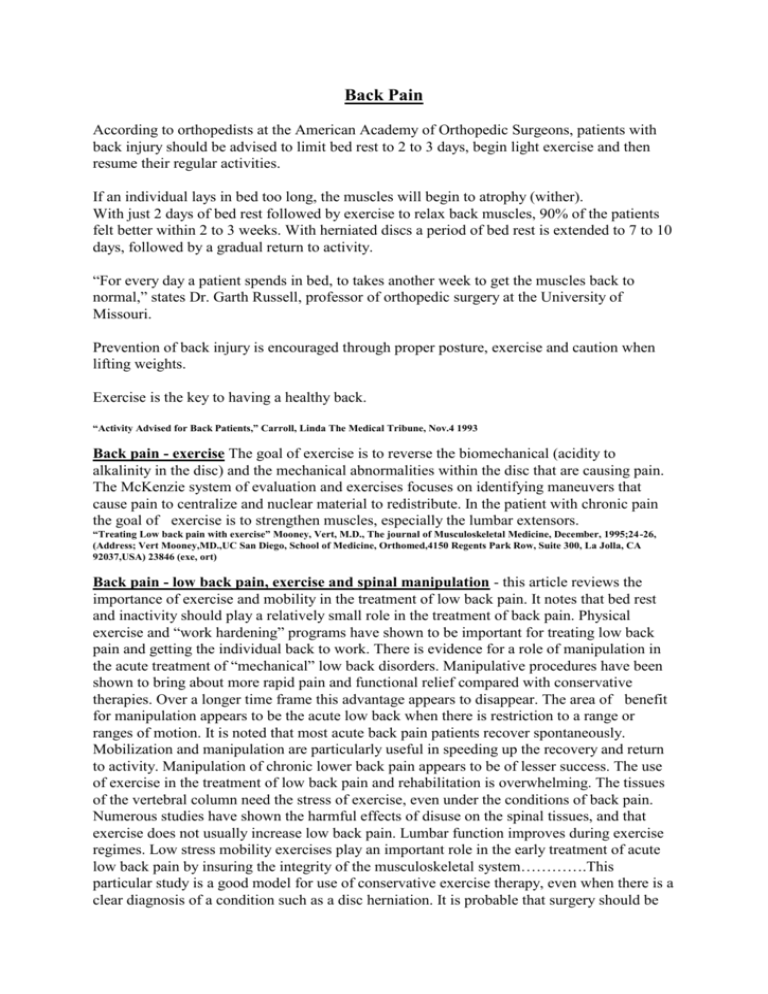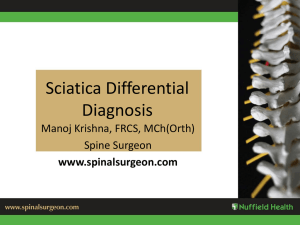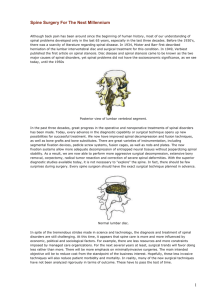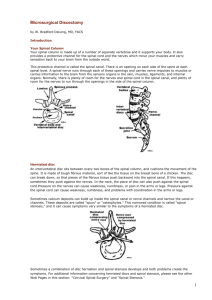Back Pain
advertisement

Back Pain According to orthopedists at the American Academy of Orthopedic Surgeons, patients with back injury should be advised to limit bed rest to 2 to 3 days, begin light exercise and then resume their regular activities. If an individual lays in bed too long, the muscles will begin to atrophy (wither). With just 2 days of bed rest followed by exercise to relax back muscles, 90% of the patients felt better within 2 to 3 weeks. With herniated discs a period of bed rest is extended to 7 to 10 days, followed by a gradual return to activity. “For every day a patient spends in bed, to takes another week to get the muscles back to normal,” states Dr. Garth Russell, professor of orthopedic surgery at the University of Missouri. Prevention of back injury is encouraged through proper posture, exercise and caution when lifting weights. Exercise is the key to having a healthy back. “Activity Advised for Back Patients,” Carroll, Linda The Medical Tribune, Nov.4 1993 Back pain - exercise The goal of exercise is to reverse the biomechanical (acidity to alkalinity in the disc) and the mechanical abnormalities within the disc that are causing pain. The McKenzie system of evaluation and exercises focuses on identifying maneuvers that cause pain to centralize and nuclear material to redistribute. In the patient with chronic pain the goal of exercise is to strengthen muscles, especially the lumbar extensors. “Treating Low back pain with exercise” Mooney, Vert, M.D., The journal of Musculoskeletal Medicine, December, 1995;24-26, (Address; Vert Mooney,MD.,UC San Diego, School of Medicine, Orthomed,4150 Regents Park Row, Suite 300, La Jolla, CA 92037,USA) 23846 (exe, ort) Back pain - low back pain, exercise and spinal manipulation - this article reviews the importance of exercise and mobility in the treatment of low back pain. It notes that bed rest and inactivity should play a relatively small role in the treatment of back pain. Physical exercise and “work hardening” programs have shown to be important for treating low back pain and getting the individual back to work. There is evidence for a role of manipulation in the acute treatment of “mechanical” low back disorders. Manipulative procedures have been shown to bring about more rapid pain and functional relief compared with conservative therapies. Over a longer time frame this advantage appears to disappear. The area of benefit for manipulation appears to be the acute low back when there is restriction to a range or ranges of motion. It is noted that most acute back pain patients recover spontaneously. Mobilization and manipulation are particularly useful in speeding up the recovery and return to activity. Manipulation of chronic lower back pain appears to be of lesser success. The use of exercise in the treatment of low back pain and rehabilitation is overwhelming. The tissues of the vertebral column need the stress of exercise, even under the conditions of back pain. Numerous studies have shown the harmful effects of disuse on the spinal tissues, and that exercise does not usually increase low back pain. Lumbar function improves during exercise regimes. Low stress mobility exercises play an important role in the early treatment of acute low back pain by insuring the integrity of the musculoskeletal system………….This particular study is a good model for use of conservative exercise therapy, even when there is a clear diagnosis of a condition such as a disc herniation. It is probable that surgery should be reserved for patients in whom function has not been improved through an intensive physical exercise rehabilitation program. “Spine update; Exercise and spinal manipulation in the treatment of low back pain”, Twomey, Lance, PhD. And Taylor, James, MD.,PhD., Spine, 1995:20950;615-619. (Address; Lance Twomey,PhD., Curtain University of Technology, GPO Box U1987 Perth 6001, Western Australia) 22856 (exe ) Pain - Back pain and Exercise - The current approach to management of low back pain favors early mobilization instead of extended bed rest. This may be due to the fact that most back pain arises from soft tissue injury. Postmortem studies have shown that rim lesions produce hemorrhage and edema from tears at the junction of the annulus fibrosis and vertebral bodies. It has been shown that gentle but progressive spinal motion can reduce this inflammatory state. This soft tissue damage can cause the nucleus of the disc to become acidic which tends to be painful. An alkaline pH is found in a degenerative disc which is not painful. Improved fluid exchange can reverse the natural state of acidic pH in the painful disc. Since the intervertebral disc lacks vascularization, enhanced fluid exchange is the only mechanism for improved cellular nutrition and removal of byproducts. Better hydration can only be achieved by physically pumping water into and out of the disc via spinal motion. Persistent pain suggests inadequate fluid exchange. Chronic pain is associated with deconditioning . One study showed that the biomechanical or mechanical changes of soft tissue injury become less reversible as time passes. Inactivity produces biomechanical changes and diminished hydration while motion increased hydration and changed the character of the proteoglycans to normal and restores normal pH…………..Patients recovering from low back problems should resume work as soon as possible. “Why exercise for low back pain? Activity reverses biomechanical changes caused by injury,” Mooney,Vert,MD The journal of Musculoskeletal Medicine October 1995:33-39. Address; Vert Mooney,MD.,Department of Occupational and Environmental Medicine, University of California at San Diego, Department of Orthopedic Surgery, School of Medicine, 330 Lewis street, San Diego, CA 92103 (619) 294-6206, USA)23387 a(ort)











